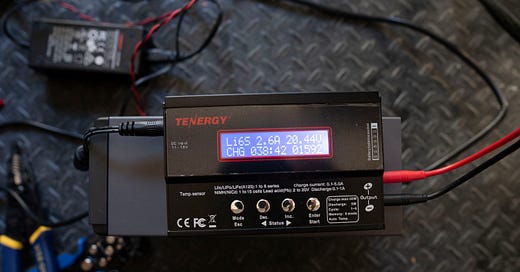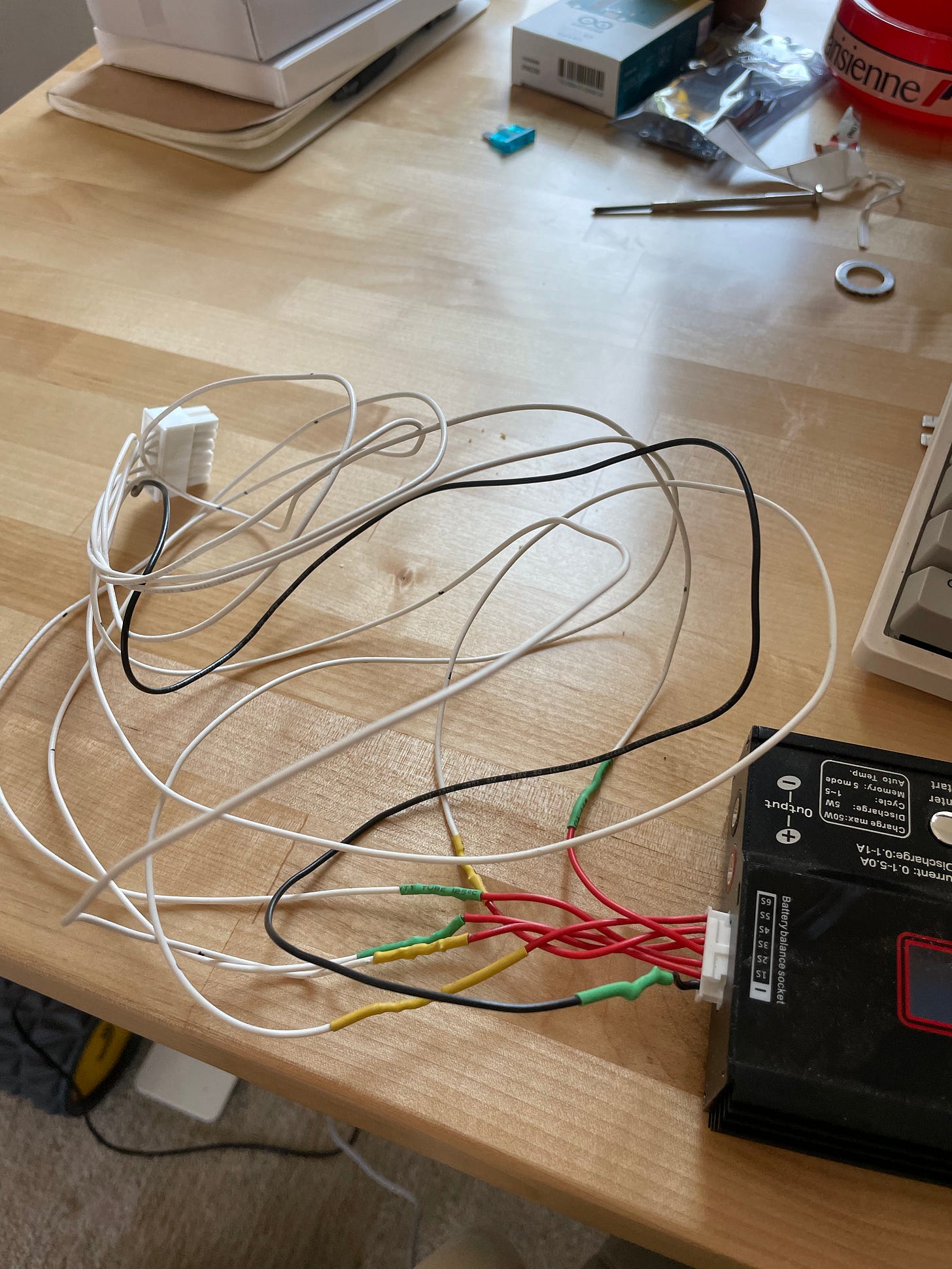How to balance Lithium ion Batteries & how I charged a Tesla battery with an RC car battery charger.
How to come really close to balancing Tesla batteries with a little RC car battery.
Why batteries need balance
Batteries, like humans, need balance. When you’re putting together a bank of lithium-ion batteries whether for your home’s solar energy storage, or for your ev conversion, or whatever it may be. If your batteries are wired in series, your battery pack capacity will really only be as good as the weakest battery, or more accurately the lowest capacity battery. So typically the recommendation is if you’re doing an EV conversion you want batteries from the same donor pack so they all are generally the same amount of charge, have been used the same amount, and have the same capacities.
Batteries wired in a series compound in voltage, but in terms of capacity are limited to the lowest capacity battery in the series. So if battery 1 is 24V 250ah and is wired in series to battery 2 which is also 24V but is 200ah. The overall pack capacity is only 200ah.
So, when I bought my batteries, I got them all from the same Tesla Model S pack. This way I could ensure they’d match in voltage and capacity. However, a momentary mistake while assembling the battery boxes (I shorted a fused battery with my socket wrench) pulled some voltage out of one of the batteries making it a bit less charged from the rest in the pack. So what was I to do?
How to balance batteries
You may be in a similar situation, or maybe you’ve got batteries from different packs, before you wire them all up and drop them in your conversion you should make sure to balance them. You may be asking, isn’t this what the BMS is for? Yes, you’d be right, a BMS actively balances your batteries, but this is done at a very micro voltage level. A BMS ensures that no individual cell wanders off in its voltage. But for larger voltage differences a BMS cannot make up the difference.
As I mentioned in the beginning wiring batteries in series increases the voltage. Wiring batteries in parallel increases capacity. Wiring batteries in parallel means connecting positive terminals to positive terminals and negative to negative. Something interesting happens when you wire batteries in parallel though. Voltage, or really, electricity likes to go from higher to lower voltage until the voltage between the two sources is balanced. In really simplified terms this is how chargers work. The charger at a higher voltage than the battery pack is connected to the battery at a lower voltage, and the electricity begins to flow until the pack reaches the voltage output of the charger.
So if you just hooked up a 22.26V battery to a 20.04V battery would it work just like your charger? Not really. What you’d see is a really bright, and maybe loud spark. The other thing your charger does besides providing a higher voltage is providing resistance. This limits the speed at which the energy flows from one place to another. This makes the balancing happen at a much safer, slower rate. So this is what we want to do to make balancing our batteries safe.
We can use resistors to limit the current by which energy flows from one point to another. But you can’t just grab any off-the-shelf resistor, you need to calculate the amount of resistance needed to limit the flow to a reasonable amount. To calculate this we can use something called Ohms law.
Per chatGPT, “Ohm's Law is a fundamental principle in electrical engineering that describes the relationship between voltage (V), current (I), and resistance (R) in an electrical circuit. It can be summarized by the equation V = I * R.”
So we know a few of the variables from this equation so we can solve for resistance. For voltage, we calculate the difference between the two battery voltages that will be connected in parallel so:
Battery 1 voltage - Battery 2 voltage = V
so
22.26 - 20.04 = 2.22V
For current we can reference the current limit of the batteries we’re using, and then also decide how much/or how fast we want the balancing to happen. So I would say we don’t want to have a whole bunch of current, the less current the slower the balancing. So I’m gonna say we want around 2-3 amps so:
I = 2
Now we can figure out how much resistance we need for this to happen. Resistors are rated by two things, their resistance in ohms, and their wattage — which we can talk about in just a minute.
So let’s go back to our initial equation: V = I * R
2.22 = 2*R
So we can divide both sides by 2 and we get
1.11 = R
So we can round that down to 1Ω. Now that we know that we can start shopping for a resistor. The other thing resistors are rated by is wattage, which in this instance we’re basically going to say it’s the resistor’s ability to dissipate heat. The higher the wattage the better the resistor will be at dissipating heat. To determine the wattage needed we need to understand the power that’s moving across the resistor with another formula from Ohms law.
P = I^2 * R
P = V * I
P = 2.22V * 2A
P = 4.4 watts (W)
So the absolute minimum wattage you could use would be 4.4 watts, but I’d go higher. And that’s what I decided to do, I went way overkill and got this 100W 1 Ohm Resistor.
From there, you’re off to the races. You just need to connect the batteries together in parallel with the resistor in line with the positive terminal connections.
But that’s not what I did. After talking with some people who know a thing or two more than I do, I went a different route. I decided to use an RC car battery charger.
How to balance Tesla batteries using an RC car charger.
Lots of RC cars use the same types of batteries as actual full-size electric cars. At least batteries with the same chemistry and voltage range. A typical lithium-ion battery has a nominal voltage of around 3.7V. This is the same wherever those batteries are used. They’re all charged to the same peak voltage of around 4.2V. Tesla batteries as you may know have a 6s74p configuration so that means there are 6 cell groupings of 74 parallel cells wired in series. So each one of those groupings although it has 74 actual literal batteries in it still has the same voltage as one individual cell 3.7V nominal.
Tesla makes it easy to access each one of these cell groupings with their cell tap boards that are directly connected to each cell group. Other battery manufacturers create similar cell tap connections to allow for balancing, charging, and discharging. Conveniently RC car battery chargers are set up in a way where they can charge batteries and monitor individual cell groupings all at once.
So I just needed a charger that could charge a 6s configuration, this way I could bring the one low battery module into an acceptable range with the rest of the pack on its own, without having to worry about resistors or parallel connections, etc.
I went with this charger, the Tenergy TB6-B Balance Charger. This charger allows you to charge batteries from a 1s - 6s configuration and has settings for multiple different chemistries of batteries.
The charger comes with a little board with plugs for different battery configurations that are common in RC car plugs. Instead of wiring into this board I just clipped the connector and wired in the Molex connector that goes directly into my Stealth EV cell tap boards (you can read about those in my BMS post). This makes it super easy to charge and monitor the charging of the battery.
So after wiring it up, I was able to choose the correct battery chemistry and start charging!
Dissimilar to a Tesla charger, the RC car charger as you can imagine is slow. It’s very low amperage so it takes hours, and I mean hours to charge any significant amount. But slow is safe in this scenario. I just hooked it up and let it charge in the garage while I was working, I set an alarm every hour or two to go check on everything, make sure nothing was melting or blowing up.
I was able to use this technique to get the battery within a hundredth of a volt from the other batteries in the pack. So it worked for me.
So there’s more than one way to balance a battery. Do whatever works for you. Or don’t, I don’t care. lol.






